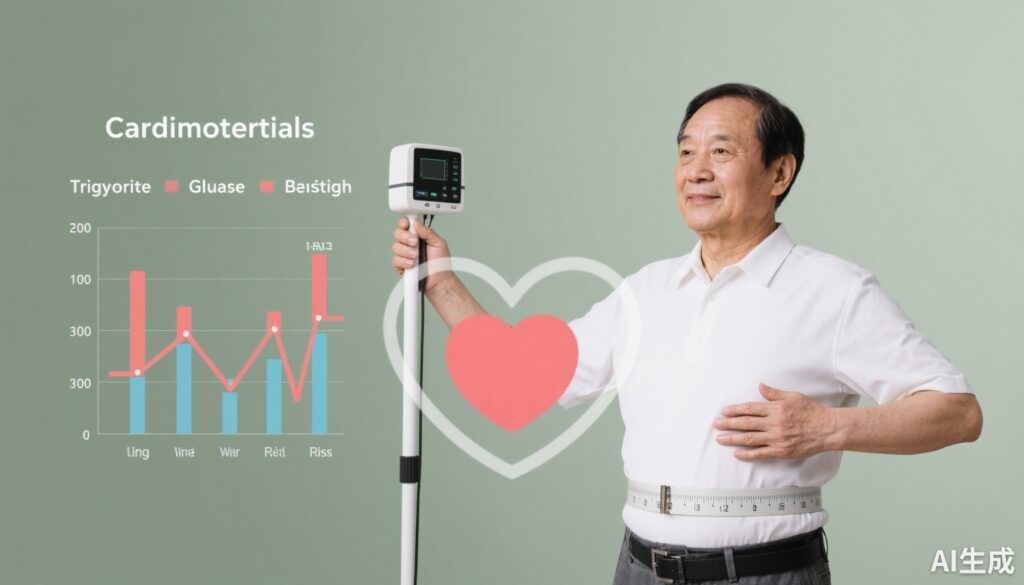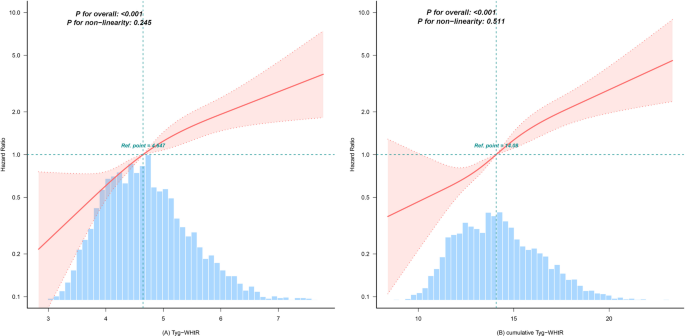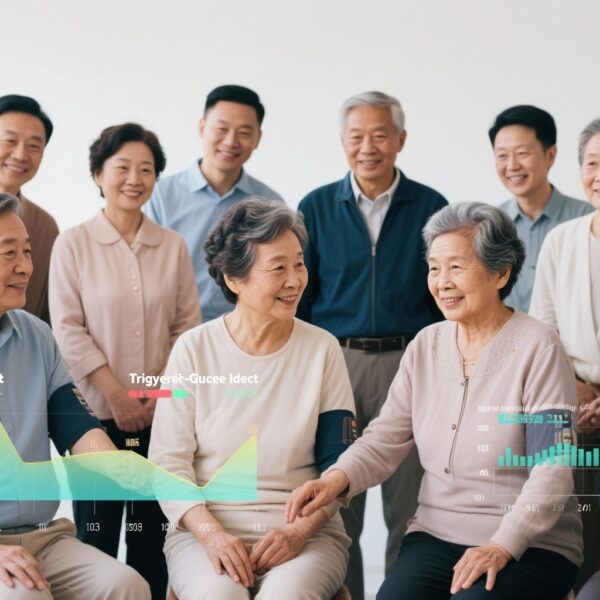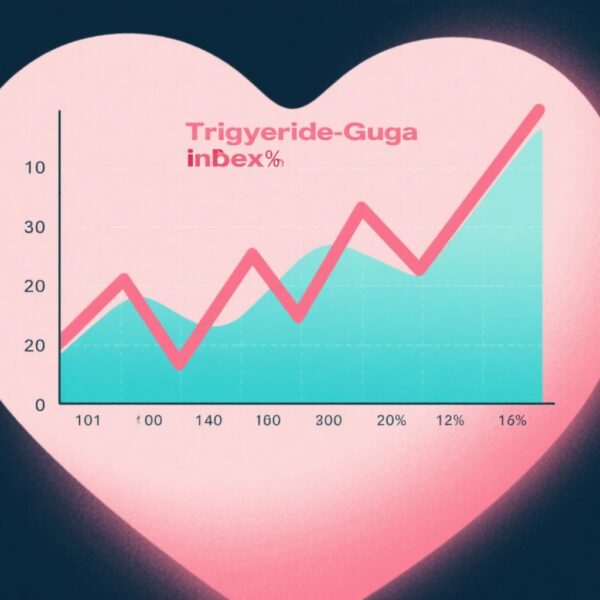Highlight
- The triglyceride glucose-waist height ratio (TyG-WHtR) index integrates metabolic and anthropometric markers, predicting cardiometabolic multimorbidity (CMM) risk.
- A prospective cohort of 4393 Chinese adults aged ≥45 showed a dose-dependent increase in CMM risk across TyG-WHtR quartiles over 9 years.
- TyG-WHtR enhanced predictive accuracy and risk reclassification beyond conventional risk factors for CMM.
- Findings support TyG-WHtR as a practical, accessible marker for early identification and prevention strategies targeting CMM in aging populations.
Background
Cardiometabolic multimorbidity (CMM) — the coexistence of two or more cardiometabolic conditions such as type 2 diabetes, hypertension, and cardiovascular disease — imposes a rapidly escalating burden worldwide, especially in aging populations. Its complexity leads to higher morbidity, mortality, and health care utilization. Identifying at-risk individuals early is paramount for timely intervention and prevention.
Insulin resistance and central adiposity are critical pathophysiological drivers underpinning CMM. The triglyceride-glucose (TyG) index is a validated surrogate marker for insulin resistance, derived from fasting triglyceride and glucose levels. Meanwhile, waist-to-height ratio (WHtR) reflects abdominal fat accumulation, correlating with cardiometabolic risk better than body mass index (BMI). Prior studies have separately linked TyG and WHtR with cardiometabolic outcomes; however, limited research has explored their combined utility.
This national prospective cohort study examines the association between a composite TyG-WHtR index and incident CMM among middle-aged and older Chinese adults, aiming to refine risk stratification and improve predictive modeling.
Study Design
The study utilized data from the China Health and Retirement Longitudinal Study (CHARLS), a large, nationally representative cohort initiated in 2011. Inclusion criteria comprised adults aged 45 years and older without CMM at baseline.
A total of 4393 eligible participants were followed through subsequent waves until 2020, with a median follow-up duration of 9 years. Baseline and cumulative TyG-WHtR indices were calculated by integrating fasting plasma triglyceride, glucose measurements, and anthropometric waist-to-height ratios.
Incident CMM was defined as the new onset of ≥2 cardiometabolic conditions during follow-up.
Statistical analyses included Kaplan-Meier survival curves to estimate cumulative incidence, multivariable Cox proportional hazards models adjusted for relevant confounders, and restricted cubic spline (RCS) modeling to examine dose-response relationships. Time-dependent receiver operating characteristic (ROC) curve analysis assessed predictive accuracy, augmented by net reclassification improvement (NRI) and integrated discrimination improvement (IDI) indices to evaluate risk reclassification ability. Subgroup and sensitivity analyses tested robustness.
Key Findings
During the follow-up period, 413 participants (9.4%) developed CMM.
A strong, positive, and independently significant association was found between TyG-WHtR and CMM risk. Multivariable Cox regression revealed hazard ratios (HRs) increasing with TyG-WHtR quartiles: compared to Q1, HRs for Q2, Q3, and Q4 were 1.75 (95% CI 1.18-2.6), 2.33 (1.58-3.43), and 3.13 (2.08-4.7), respectively, highlighting a graded dose-response pattern.
Cumulative TyG-WHtR exposure further amplified risk prediction, corroborating the effect of prolonged metabolic and adiposity burden.
Restricted cubic spline curves for CMM by TyG-WHtR (A) and cumulative TyG-WHtR (B) after covariate adjustment. Heavy central line represents the estimated adjusted hazard ratio, with shaded ribbons denoting 95% confidence interval. The model is adjuste d for age, gender, marital status, educational level, residence, smoking status, drinking status, hypertension, dyslipidemia, cancer, systolic blood pressure, diastolic blood pressure, total cholesterol, HDL-C, and LDL-C
Restricted cubic spline analyses depicted a linear relationship without evident threshold, suggesting that even moderate increases in TyG-WHtR translate to elevated CMM risk.
Importantly, incorporation of baseline and cumulative TyG-WHtR into predictive models significantly improved discrimination (area under the ROC curve) and reclassification metrics (NRI and IDI), outperforming models based solely on traditional risk factors.
Sensitivity analyses confirmed the stability of these associations across age, sex, urban-rural residence, and baseline metabolic status subgroups.
Expert Commentary
This study adds a novel dimension to cardiometabolic risk assessment by integrating two established markers — TyG and WHtR — into a composite index that synergistically enhances prediction of multimorbidity. The large, prospective design with repeated measures strengthens causal inference and clinical relevance.
Mechanistically, elevated TyG reflects insulin resistance, a systemic metabolic disruption propelling hyperglycemia and dyslipidemia, while increased WHtR captures central fat deposition, a source of proinflammatory adipokines exacerbating vascular and metabolic derangements. Their combined elevation likely denotes an amplified pathogenic milieu fostering CMM.
However, generalizability to non-Chinese populations requires validation given ethnic and lifestyle variability. The observational nature precludes establishing direct causality. Residual confounding by unmeasured factors such as diet or physical activity is possible. Moreover, clinical utility demands prospective trials testing interventions targeting TyG-WHtR components.
These findings align with current guidelines emphasizing holistic metabolic and anthropometric evaluation in cardiometabolic risk management but extend them by proposing a simple, integrative index for refined stratification.
Conclusion
The triglyceride glucose-waist height ratio (TyG-WHtR) index independently predicts the risk of developing cardiometabolic multimorbidity among middle-aged and older Chinese adults. The linear, dose-response association and enhancements in predictive accuracy underscore its potential utility as a practical risk assessment tool.
Incorporating TyG-WHtR into routine screening could facilitate early identification of high-risk individuals, enabling timely lifestyle or pharmacological interventions to curb progression of CMM. Future research should explore intervention trials and external validation to consolidate these promising findings.
Funding and Registration
Funding information was not provided in the primary article abstract. CHARLS is supported by national and international scientific grants.
References
Lv L, Zhang P, Chen X, Gao Y. The association between triglyceride glucose-waist height ratio index and cardiometabolic multimorbidity among Chinese middle-aged and older adults: a national prospective cohort study. Cardiovasc Diabetol. 2025 Sep 2;24(1):358. doi: 10.1186/s12933-025-02919-x IF: 10.6 Q1 . PMID: 40898229 IF: 10.6 Q1 ; PMCID: PMC12406543 IF: 10.6 Q1 .
Additional references for context:
1. Gurung RL, McKinney C, McKeown M, et al. The triglyceride-glucose index and risk of cardiometabolic diseases: A systematic review and meta-analysis of population-based studies. Clin Nutr. 2023;42(1):180-191.
2. Browning LM, Hsieh SD, Ashwell M. A systematic review of waist-to-height ratio as a screening tool for the prediction of cardiovascular disease and diabetes. Nutr Res Rev. 2010;23(2):247-269.




